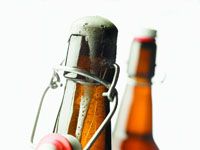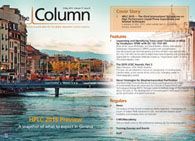Analyzing Shipwrecked Beer from 1840s Using GC–MS
Beer from a 1840s shipwreck in the Baltic Sea has been analyzed by a team of scientists at the VTT Technical Research Centre in Finland. Using a variety of chromatography techniques - including gas chromatography coupled to mass spectrometry (GC–MS) and high-performance anion-exchange chromatography (HPAEC) coupled to MS - the team compared the beer with modern-day varieties and found they were not too dissimilar.
Photo Credit: Foodcollection RF/Getty Images

Beer from a 1840s shipwreck in the Baltic Sea has been analyzed by a team of scientists at the VTT Technical Research Centre in Finland.1 Using a variety of chromatography techniques - including gas chromatography coupled to mass spectrometry (GC–MS) and high-performance anion-exchange chromatography (HPAEC) coupled to MS - the team compared the beer with modern-day varieties and found they were not too dissimilar.
In 2010 a shipwreck was discovered near the Åland Islands in the Baltic Sea at a depth of 50 m. On-board were more than 150 bottles of champagne and five beer bottles. One of the beer bottles cracked in the divers’ boat and the liquid that emerged looked and tasted like beer. Lead author of the study, Brian Gibson, explains why they were interested in studying the liquid: “Firstly, there was an element of intellectual curiosity. Samples such as these are exceptionally rare and we were very interested to discover as much as possible about the beers, how they were made, what the beer styles were, what the original ingredients may have been. Secondly, the research could provide valuable practical information on the nature of beer ageing and spoilage. This information may help us in our efforts to maintain beer quality and consistency.”
It was clear from an initial sensory analysis that the beers were too degraded to reveal anything about the style or composition. The chemical analysis was therefore essential to determine what flavour compounds were present. The team used a variety of chromatographic techniques to analyze the samples. Gibson told The Column: “In most cases we used techniques that are recommended by the brewing industry. These include HPAEC–MS for sugars, high performance liquid chromatography coupled to refractive index detection (HPLC–RI) for organic acids, HPLC–MS–MS for hopâderived bitter compounds, GC coupled to electronâcapture detection (ECD) for carbonyl compounds, GC with flame ionization detection (FID) and GC–MS for volatile aroma compounds and short chain fatty acids, and ultrahigh-pressure LC (UHPLC) for phenolic compounds.”
The team concluded that the beers were relatively mild, around 5% in alcohol. “We could tell from the hop analysis that the hops used were relatively unrefined and probably gave a slightly harsher taste than we would be used to. The aroma compound concentrations were somewhat similar to those found in modern beers but we detected an unusually high level of 2-phenylethanol, a higher alcohol that imparts a floral or rose-like note to the flavour profile,” Gibson stated. Of particular interest to the team was the contaminant bacteria, which had survived in the bottle for over 170 years without any additional supply of nutrition. The bacteria have now been isolated and are being analyzed at VTT.
A local brewery situated close to where the ship was found was able to recreate the beer. Named Stallhagen Historic 1843, it is available to buy in Finland. - K.M.
Reference
1. John Londesborough, Michael Dresel, Brian Gibson, et al., Journal of Agricultural and Food Chemistry 63(9), 2525–2536 (2015).

Analytical Challenges in Measuring Migration from Food Contact Materials
November 2nd 2015Food contact materials contain low molecular weight additives and processing aids which can migrate into foods leading to trace levels of contamination. Food safety is ensured through regulations, comprising compositional controls and migration limits, which present a significant analytical challenge to the food industry to ensure compliance and demonstrate due diligence. Of the various analytical approaches, LC-MS/MS has proved to be an essential tool in monitoring migration of target compounds into foods, and more sophisticated approaches such as LC-high resolution MS (Orbitrap) are being increasingly used for untargeted analysis to monitor non-intentionally added substances. This podcast will provide an overview to this area, illustrated with various applications showing current approaches being employed.








